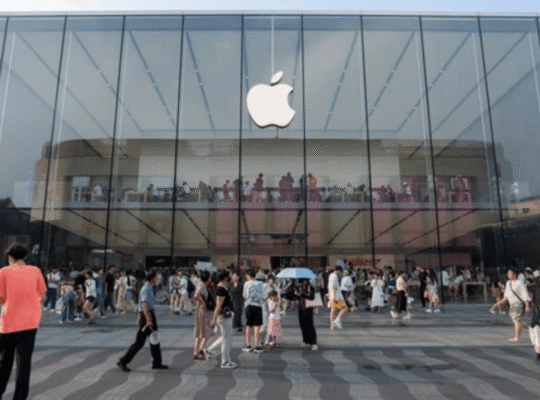Introduction
Apple’s iOS updates have constantly been eagerly predicted, no longer only for their performance boosts and new features, but also for the visual polish and user interface enhancements that make the iPhone and iPad an enjoyable experience top rate. With the discharge of iOS 26 Beta 2, Apple continues its tradition of marrying aesthetic sophistication with realistic functionality. One of the most talked-about improvements in this launch is the enhancement of the Liquid Glass interface—a design philosophy and system-wide aesthetic shift that goals to make the digital interaction experience greater natural, fluid, and immersive.
The Liquid Glass interface isn’t always only a visual improvement. It’s an enjoyable enhancement, blurring the road between digital content and the tactile sensation of bodily glass. In iOS 26 Beta 2, Apple refines this approach even in addition, introducing richer animations, deeper textures, and an even more intuitive experience of spatial orientation. This blog explores the whole thing that has changed, why it has subjects, and what it signals approximately the destiny of cellular operating systems. Whether you are a tech enthusiast, a developer, or a casual consumer, this evolution marks a thrilling chapter in Apple’s layout journey.
Understanding the Liquid Glass Interface
The Liquid Glass interface was first brought subtly in earlier iOS versions as part of Apple’s broader shift towards translucency, depth, and realism. It brings a smooth, sleek, and nearly 3-dimensional look to the user interface factors. In its handiest clarification, Liquid Glass is about creating UI that mimics the properties of glass: reflective, dynamic, and layered. When interacting with such factors, customers get the sense that they may be peering into a digital world in the back of a sheet of living, reactive glass.
This philosophy aligns with Apple’s ongoing efforts to humanize technology. Instead of cold, flat images, users interact with surfaces that breathe and reply to the touch and movement in a manner that feels herbal. With iOS 26 Beta 2, this interface has been greater both visually and functionally, pushing the bounds of what smartphones can supply in terms of sensory experience.
What’s New in iOS 26 Beta 2’s Liquid Glass Enhancements
In iOS 26 Beta 2, Apple has substantially upgraded the Liquid Glass interface. This includes not handiest extra vivid animations and transitions but also stepped transparency dynamics, richer haptics integration, and the addition of spatial audio cues that decorate the visual experience with subtle sound effects. The result is a UI that doesn’t just appear true—it feels alive.
One important improvement is in the way backgrounds and foreground factors engage. Panels and home windows now bend and deform light slightly, relying on the content at the back of them, much like real glass. This adds a layer of depth and realism to the interface that was formerly lacking. Touch responsiveness has additionally been superior to match those visuals, with greater nuanced haptic remarks that simulate pressing on bendy, resilient surfaces.
Apple has also tuned the Liquid Glass interface to be greater energy-efficient. Through wise rendering and adaptive refresh rates, the more complicated animations do not compromise battery life. This makes it feasible to experience a rather dynamic interface without out stressed about performance drain.
A New Standard for Translucency and Depth
The new translucent panels in iOS 26 Beta 2 are an enormous leap ahead. They now adapt contextually based on the colour of the wallpaper, mild intensity in the surroundings, or even the time of day. These micro-modifications create an interface that is usually in harmony with its environment, in place of searching artificially imposed search.
In notification banners, quick access panels, and widgets, Apple has delicate the blur results and shadow contours. Instead of static elements, they experience like suspended layers floating atop the screen. Apple’s use of parallax effects has also been cautiously recalibrated, fending off nausea-inducing movement even as it nevertheless presents a sense of spatial layering that draws customers into the interface.
These diffused modifications signal a shift from conventional flat layout to an extra interactive and reactive aesthetic. Apple isn’t reverting to skeuomorphism; however, evolving past minimalism to something greater, sensory, and experiential.
Enhanced Motion Design and Interaction
Motion design in iOS 26 Beta 2 plays a vital role in bringing the Liquid Glass interface to lifestyles. Buttons now compress barely whilst pressed, with diffused visual distortions that mimic strain on a pane of glass. Sliding between apps or navigating gadget menus outcomes in seamless fluid transitions, without any perceptible stutter.
App release animations have additionally been made over. When customers tap an app icon, the icon expands and morphs into the app window with a refractive ripple effect, as if it’s rising through a liquid floor. Closing an app reverses this effect with a gentle suction-like animation, giving a feeling of completion and order.
These design factors aren’t merely aesthetic—they manually capture consumer attention and decrease cognitive load. By making transitions extra intuitive and herbal, Apple minimizes friction and complements usability.
Accessibility and Liquid Glass
One of the predominant achievements of this interface evolution is the way it remains inclusive and reachable. Apple has constantly emphasized accessibility, and the Liquid Glass enhancements are no exception. For users with visual impairments, the dynamic lights and intensity cues provide additional orientation without being disorienting. The evaluation ratios were maintained at ADA-compliant stages, making sure clarity even on layered or translucent surfaces.
VoiceOver customers additionally enjoy the Liquid Glass interface. UI factors now respond to audio cues with diffused movement, supporting users to understand spatial relationships better. Tactile feedback from the haptic engine reinforces these interactions, creating a multisensory revel that’s more inclusive than ever before.
Apple’s careful balance among beauty and accessibility guarantees that innovation does not come at the fee of usability for all and sundry.
Developer Tools and Customization
With iOS 26 Beta 2, Apple has also rolled out enhanced developer gear that allows app creators to take advantage of the Liquid Glass design language. These consist of new APIs for dynamic blur effects, intensity-sensitive rendering, and adaptive movement patterns. Developers can now design interfaces that experience local to iOS 26’s aesthetics while keeping their brand identification.
Apple has also supplied customizable layers and remark settings, allowing app builders to pick out how their interface elements respond to mild, touch, and motion. This permits third-party celebration apps to completely include the Liquid Glass well-known, making the entire gadget feel consistent and polished.
This circulation facilitates unifying the app surroundings visually and functionally, providing users a continuous enjoy no matter which app they may be the usage of.
User Customization and Personalization
One of the criticisms of past iOS versions has been the limited scope for personalization. Apple has addressed this with iOS 26 Beta 2 by means of offering deeper customization alternatives for customers. Through the Settings app, customers can now regulate the depth of glass consequences, alter movement settings, and pick from a range of “interface tones” that alter the colour, warm temperature, and vibrancy of UI elements.
There are new themes that subtly shift the visual temperature of the Liquid Glass results, letting customers set a temper, from cool and calming to warm and colourful. Combined with new lock display screen customization alternatives and dynamic wallpapers, this allows for an extraordinarily private device experience.
This degree of personalization enhances user delight and loyalty, permitting people to tailor their virtual environment to healthy their personality and daily desires.
Performance and Optimization
One of the largest questions surrounding any new visible upgrade is performance. Apple has historically prioritized smooth overall performance throughout devices, and the Liquid Glass enhancements are no specific. IOS 26 Beta 2 has been optimized to make sure that even older models, just like the iPhone 14 and 15 colseriesan run the interface fluidly.
Using machine learning algorithms, the OS dynamically scales visual fidelity based on to be had machine assets. This approach is that complicated animations are more effective when rendered in complete detail, whilst overall performance allows, averting battery drain or lag. This shrewd, useful resource management enables a consistent enjoy throughout devices without compromising the signature Apple polish.
This approach guarantees that the Liquid Glass interface stays inclusive for all customers, regardless of whether they’re using the modern hardware or an older model.
Implications for Future iOS Releases
The enhancement of the Liquid Glass interface in iOS 26 Beta 2 isn’t always only a transient visible improvement. It’s a step toward a broader evolution in how people interact with their gadgets. The line between hardware and software programs keeps to blur, and interfaces are becoming increasingly immersive, reactive, and context-conscious.
These modifications factor into a destiny wherein digital interactions will more closely mimic actual-global physics and sensations. Apple is positioning itself at the vanguard of this trend, and the Liquid Glass machine may want to end up a key issue of destiny AR and spatial computing structures. With Vision Pro and different spatial products on the horizon, the mixing of tactile, visible, and audio elements right into a cohesive interface becomes even more relevant.
IOS 26’s enhancements show Apple’s long-term approach of regularly guiding users right into a destiny wherein their devices feel more like extensions of themselves than just equipment.
User Reactions and Early Feedback
Beta testers and early adopters have undoubtedly responded to the Liquid Glass enhancements in iOS 26 Beta 2. Many users report that the interface feels extra “alive” and “personal,” praising its elegant animations and tactile responsiveness. Developers have additionally expressed appreciation for the updated toolkits that allow them to convey their apps in line with the brand new layout language without problems.
Some users have stated a moderate adjustment curve while adapting to the deeper spatial layers; however, most agree that the revel in feels rewarding once accustomed. Battery overall performance stays stable, and there were few reviews of instability or overheating, indicating that the visual upgrades had been nicely optimized.
The positive remarks underscore Apple’s success in delivering a meaningful and useful upgrade in place of a superficial facelift.
Conclusion
With iOS 26 Beta 2, Apple has made vast strides in redefining what a modern-day mobile interface can be. The superior Liquid Glass interface is not merely a visible novelty but a considerate integration of art, science, and person-centric design. It reflects Apple’s commitment to handing over emotionally resonant, tactile digital experiences that engage the senses and increase day-to-day interactions.
By enhancing translucency, responsiveness, and personalization whilst maintaining overall performance and accessibility, Apple has set a new standard for cellular UI. As digital devices end up ever more relevant to our lives, the significance of a responsive, fashionable, and immersive interface can’t be overstated. The Liquid Glass improvements constitute a significant step in that path, one which customers will experience whenever they liberate their telephones or tap on a display.
Frequently Asked Questions (FAQs)
Q1: What is the Liquid Glass interface in iOS 26 Beta 2?
A: The Liquid Glass interface in iOS 26 Beta 2 is a visually more suitable person interface layout that mimics the appearance and behavior of real glass. It contains advanced translucency, layered results, and responsive animations to create a more immersive and natural user enjoy.
Q2: How is Liquid Glass extraordinary from previous iOS designs?
A: Unlike preceding designs that emphasised flat or minimalistic factors, the Liquid Glass interface introduces depth, movement, and realism. It reacts to touch, lights, and device motion in more reasonable ways, making interactions feel smoother and greater responsive.
Q3: Does the Liquid Glass interface affect battery life?
A: Apple has optimized the Liquid Glass improvements to be strength-efficient. The system makes use of intelligent rendering and adaptive animations that preserve clean overall performance without a big impact on battery life, even on older iPhones.
Q4: Can I flip off or adjust Liquid Glass results in iOS 26?
A: Yes, users can customize or reduce Liquid Glass effects through the Settings app. Options encompass adjusting movement sensitivity, transparency ranges, and deciding on interface issues to customise the appearance and feel of the UI.
Q5: Is the Liquid Glass interface available to users with disabilities?
A: Absolutely. Apple has designed the interface improvements with accessibility in mind. The system continues excessive contrast tiers, helps VoiceOver with responsive animations, and affords tactile remarks to assist users with diverse accessibility wishes.
Q6: Will 1/3-party apps aid the Liquid Glass interface?
A: Developers have get entry to to new APIs that permit their apps to integrate with the Liquid Glass layout language. This way, many famous apps will undertake comparable visual and interactive elements, creating a unified experience throughout the machine.
Disclaimer
Created with the Synergy of AI innovation and through research, this article is intended to offer clear, accurate, and actionable insights. Each point has been double-checked to ensure it adds genuine value to your knowledge base. Our mission is to guide you with reliable, easy-to-understand information. Enjoy your reading experience and continue exploring new ideas!






